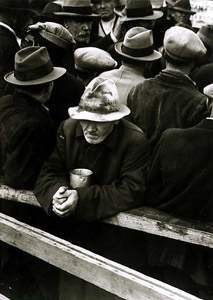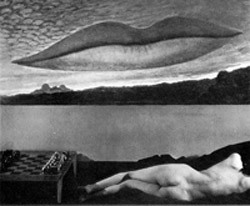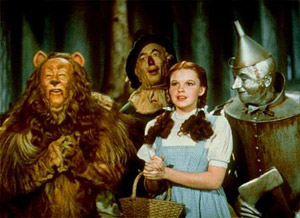
Art's Portrayal of the 1930s
 Art is one of the most important aspects of the 1930s and without artists such as Dorothea Lange and Man Ray, the world would have a very limited view of life in the 1930s. Lange photographed the Great Depression and in doing so shined a light on the circumstances of the time period. Man Ray was also an artist in many different arts and portrayed his own view of the Great Depression. Lange tried to obtain the most realistic and raw image possible, whereas Ray often created abstract art. Both hold equal importance during the 1930s, as well as the present.
Art is one of the most important aspects of the 1930s and without artists such as Dorothea Lange and Man Ray, the world would have a very limited view of life in the 1930s. Lange photographed the Great Depression and in doing so shined a light on the circumstances of the time period. Man Ray was also an artist in many different arts and portrayed his own view of the Great Depression. Lange tried to obtain the most realistic and raw image possible, whereas Ray often created abstract art. Both hold equal importance during the 1930s, as well as the present.
Dorothea Lange was born May 25, 1895 in Hoboken, New Jersey. At six years old she caught polio, which gave her a permanent limp. Her father left home when she was 12 years old. Her mother was a people-pleaser and Lange was always the complete opposite and never could understand her mother's actions. She and her mother lived with her drunk grandmother for the majority of her childhood. Her mother worked at a library in Manhatten and Lange went there often to read. She especially loved to read Shakespeare. She attended Public School 62 before graduating to Wadleigh High School located in Harlem. She did best in English, drawing, and music classes. However, she extremely disliked school so she often ditched until she eventually just left altogether. She later found work as an apprentice for Arnold Genthe. This taught her how to develop film and other similar actions. She attended Columbia University and majored in photography. She is most recognized for her photographs of the Great Depression and Japanese American detention camps formed after Pearl Harbor. Migrant Mother, photographed in 1936, Children of Migrant Workers, also photographed in 1936, White Angel Beadline photographed in 1932, and Woman of the High Plains, photographed in 1938, are a few examples of Lange's work. She died October 11, 1965 in Indio, California.
 Man Ray was born August 27, 1890 in Philadelphia, Pennsylvania. He was named Emmanuel Radnitzky at birth. His parents were Russian-Jewish immigrants. He never revealed much of anything about his youth or family, so there's not much to write about that topic. He spent most of his life in Paris. He was a photographer, painter, sculptor, inventor, and constructor of unusual objects and collages. He also liked to experiment in rayographs. He's most known for his photography and paintings. Picasso and Dali were colleagues of his. He took part in the Dada art movement and the Paris Surrealist movement. He regularly gave lectures on surrealist art. Some examples of Ray's work are Le Violon d' Ingres, photographed in 1924, Jacqueline Goddard, photographed in 1930, Juliet and Margaret, photographed in 1948 and Observatory Time - The Lovers, photographed in 1936. He died November 18, 1976.
Man Ray was born August 27, 1890 in Philadelphia, Pennsylvania. He was named Emmanuel Radnitzky at birth. His parents were Russian-Jewish immigrants. He never revealed much of anything about his youth or family, so there's not much to write about that topic. He spent most of his life in Paris. He was a photographer, painter, sculptor, inventor, and constructor of unusual objects and collages. He also liked to experiment in rayographs. He's most known for his photography and paintings. Picasso and Dali were colleagues of his. He took part in the Dada art movement and the Paris Surrealist movement. He regularly gave lectures on surrealist art. Some examples of Ray's work are Le Violon d' Ingres, photographed in 1924, Jacqueline Goddard, photographed in 1930, Juliet and Margaret, photographed in 1948 and Observatory Time - The Lovers, photographed in 1936. He died November 18, 1976.
 Apart from these artist's art, several categories of art were profoundly flourishing during this time. Film is a great example of this art progression. Films were extremely important to those that were wealthy and also to those that were poor. It affected everyone all around. To see a new and exciting film was an admittance into another world seperate from their own. Busby Berkeley pushed toward an incomprehensible excellence and succeeded in gravitating hundreds of eager people toward his crazily unique shows. The Wizard of Oz and Gone with the Wind are two additional examples of film that were born in the 1930s and are still cherished today. Music, focally swing, was very popular during this time as well. Artist's enjoyed painting murals on the lobby walls of government buildings. Finger painting became really popular in 1931, too. Art, for many, was taken advantage of to temporarily depart from their chaotic and suffering world. To witness this chaos and suffering also added a new perspective on life and the way art was created.
Apart from these artist's art, several categories of art were profoundly flourishing during this time. Film is a great example of this art progression. Films were extremely important to those that were wealthy and also to those that were poor. It affected everyone all around. To see a new and exciting film was an admittance into another world seperate from their own. Busby Berkeley pushed toward an incomprehensible excellence and succeeded in gravitating hundreds of eager people toward his crazily unique shows. The Wizard of Oz and Gone with the Wind are two additional examples of film that were born in the 1930s and are still cherished today. Music, focally swing, was very popular during this time as well. Artist's enjoyed painting murals on the lobby walls of government buildings. Finger painting became really popular in 1931, too. Art, for many, was taken advantage of to temporarily depart from their chaotic and suffering world. To witness this chaos and suffering also added a new perspective on life and the way art was created.
Every action and every thought is art. From the way words are written to paintings as elaborate as Sunday in the Park with George by Georges Seurat. Everyone holds a different perspective in life and each perspective is just as important as another's. Translating these perspectives is vital to our understanding of life. This is why Dorothea Lange and Man Ray are so important to the history of the 1930s. They both included their input for the purpose of sharing their perspective and originality. Our generation as well as many future generations to come will appreciate this.
Essay Sources:
Turner, Robyn Montana; Dorothea Lange; Robyn Montana Turner; 1994
Art Styles; http://martinlawrence.com/styles.html
American History - 1930- 1939; http://kclibrary.nhmccd.edu/decade30.html
A Practical Dreamer; Man Ray | Biography; http://imageexchange.com/exhibits/manray/intro1.shtml
Photograph Sources:
Pagan themes in Classicle Music; http://laughingunicorn.com/Pagan_Themes.htm
What Does a Person Deserve? The Answer Found...; http://www.mindspring.com/~davidmbernstein/Dorothea_Lange.html
Comparative Culture 03; http://www.kyushu-ns.ac.jp/~allan/Documents/societyincinema-03.htm
DVD Review: Wizard of Oz (Two-Disc Collector'...; http://dvd.monstersandcritics.com/reviews/article_10468.php/DVD_Review_Wizard_of_Oz__Two-Disc_Collectors_Edition_